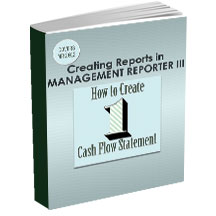In charge of financial reporting?
You’re Organized. Successful. Capable. Impressive. Fast. Efficient. Powerful. In Charge. A Financial Superstar.
Until you get to the cash flow.
Then, when you add Management Reporter to the mix, this:

Becomes this:

Floundering. Bumbling. Screwball.
Maybe you’ve managed so far without a cash flow.
Or maybe you’ve put something together in Excel. Maybe it ties out. Maybe it doesn’t.
And it takes forever. Every month. Or maybe it’s just too much trouble for monthly. So it gets pushed out to quarterly—or even annually.
But there’s just one little problem: it’s not often enough. And it’s not representative of the quality work you do.
Add Management Reporter into the mix and maybe you want to back off slowly. Like you’ve seen a mountain lion.
Even most consultants fear them.
Why is it so difficult? As you already know, a cash flow is a wacky combination of the period change and year to date change and beginning of year balances and end of year balances and beginning of period balances. Then when you stir in Management Reporter, it’d be a miracle if it wasn’t time-consuming and confusing.
Turns out, you don’t need to struggle with this. You just need a proven technique for knocking this out of the park.
Whether you’re presenting to the Board, or adding a report to the financial package, or answering a colleague’s request for help, one thing’s for sure: a sophisticated cash flow can propel you to financial rockstar status.
Enter Creating Reports in Management Reporter III—How to Create 1 Cash Flow Statement With Three Variations and Optional Link to Excel.

There IS a better way—I teach a fast, simple, effective way to approach cash flows. It’s a game changer.
I LOVE this simplified method of doing cashflows. No column placement needed! I’ve used this method for years, starting back-in-the-day with FRx.
So many times, it’s made me look like a rockstar.
Here’s what’s up:
- How to create an initial balance-sheet-only internal Month To Date and Year To Date cash flow
- How to create variation 1—Trend January to December
- How to create variation 2—Rolling Three Month
- How to create variation 3—Quarter End
- How to use one row definition for all 4 versions of the internal cash flow
- How to link to Excel for the primary report and all 3 variations
- How to use the link to Excel to split Notes into Proceeds and Repayments, and Fixed Assets into Purchases and Proceeds
- Learn exactly what the Excel spreadsheet should look like
- How to make sure the Excel information ties to the GL
- Learn the best place to put the Excel file so Management Reporter sees it
- Learn when you might want to stop with the internal cash flow and not to link to Excel
- How to link to Excel to pull cash flow data for multiple companies
- How to check accuracy on every cash flow
- How to add noncash P&L items without going out of balance
- How to use this simplified method to avoid advanced column placement
- How to use an analytical, step by step approach to keep a cash flow in balance
Once you understand this method, it’s not hard to create your own variations. And you can run the non-Excel version every day if you want, so use it to help manage cash.
Imagine inserting 4 cash flow statements into the monthly reporting package.
BTW, the technique I teach is completely different from the cashflow in the demo reports. The demo report uses a far more complex method. It uses advanced column placement, something that looks like this for ending cash: “CAL B=C.1270, E=C.1270”. Trouble is, column placement won’t work unless you know to set the calculation priority correctly. And it’s not well suited for adding variations. I don’t love it.
The Details
- Price $199
- Immediate download—there’s NO hard copy. I recommend you put on 2nd monitor or iPad so you can make the images bigger if needed. I wouldn’t print this because some of the screenshots should be viewed at over 100%.
- Version—I’m using Management Reporter 2012 RU5. This technique works whether your ERP is GP or AX or SL.
- Date—Finished October 2013
- Self-study tutorial
- These pages are packed with commented screenshots. I use ‘Here’s what I’m thinking’ callouts, things I’d say if I were with you in person, helping you walk through this step by step. Here’s a sample.
- Finished reports—1 cash flow and 3 variations balance-sheet-only
- Finished reports—1 cash flow and 3 variations adding P&L noncash items and linking to Excel to pull FASB info
- Finished reports—1 cash flow consolidation that links to Excel to pull FASB info
- Quarter End included (Yes Quarter End. I can see you’re skeptical. Believe it.)
- Money back guarantee—no risk 30-day money back guarantee
- Credit cards are Visa, Mastercard, American Express and Discover in a secure shopping cart
- The same concepts apply to FRx, so you can conceivably use this manual for FRx.
- Audience—consultants and end users
- Most-asked Question—There’s not a discount for buying more than one of the 3 manuals, sorry. I did this for a little while, but it quickly became hair-raising when I issued updates to one manual and not the other.
Gotcha’s
Don’t you hate it when you buy something and some little fine print something jumps up to bite you? No fine print here:
- This course is not for Management Reporter beginners. You should know your way around.
- This technique does not work in the early versions of MR. Check your version at Help > About. If it’s 2.0, don’t bother. You’ll need to use advanced column placement as mentioned above. I don’t cover this. But you can look in the demo reports. (Bless your heart.)
- This method works for all versions of MR 2012 (version 2.1.xxxx), but I’ve had one purchaser tell me she needed to have CU7 installed for it to work.
- You need a balance sheet, in balance, to start.
- If your beginning balances are screwy (I’m looking at you, GP!) you’re on your own.
- This is self-study and doesn’t include any consulting.
It’s so easy to pair a cashflow row with different columns, especially when using the internal version without linking to Excel. I hope it will fire your imagination, allow you to create many versions, and save you tons of time.
Pretty soon you’ll be saying “Cash Flow? BRING IT.”
And you’ll be back to James Bond-status, or the female equivalent, in no time. Cheers—Jan
“Jan, I purchased your manuals and so far they have been very easy to follow and useful.” —G. Waddell re MR I and II manuals
“Jan Harrigan of FRxBuzz has updated her fantastic MR materials to include instructions on how to build a Cash Flow statement in MR 2012.” —Mark Polino Dynamics GP MVP
“Hi Jan, I recently purchased your 3 management reporter instruction manuals. I have made great use of them and can now prepare several reports including the cash flow statement with links to Excel. Thank you so much for the effort you put into these manuals. I use the manuals for Dynamics AX 2012.” —B. Patterson re MR I, II and III manuals
PS. Update on September 1, 2017: By popular demand, I’ve finally added a discount for purchasing the set of all 3 Management Reporter manuals. Here is a link to lots of information on the other two manuals: Creating Reports in Management Reporter I and II and below is the buy-all-3-at-once button. They’re priced at $199 each, but save a total of $150 when you buy them all. Cheers…Jan

